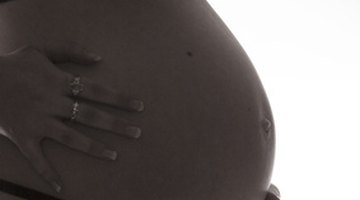Signs Mothers Should Expect When the Baby's Head Is Engaged at the Pelvis
Engagement, or lightening, refers to a baby's descent into the pelvis. When a baby is fully engaged -- or at 0 station -- his head rests against the narrowest part of your pelvis. For 65 percent of first-time moms, engagement occurs up to two weeks before labor begins, according to childbirth educator Catherine Beier. Moms who have given birth may find their babies do not engage until labor begins. While engagement cannot tell you exactly when you will go into labor, it does indicate that your body is preparing for giving birth.
Symptom Relief
When a baby engages, her lower position in your pelvis relieves pressure on your ribs, lungs and stomach, which lessens some unpleasant pregnancy symptoms. You may be able to eat more at one time without feeling too full, breathe more easily and experience less heartburn. Since your baby has dropped from under your ribcage, you may find that she does not kick you as painfully in the ribs anymore.
Increased Pressure

When Does The Baby Drop?
Learn More
Other symptoms worsen once your baby has shifted his position down into your pelvis. Increased pressure on your bladder causes you to urinate more often and makes it difficult to sleep at night if you wake up multiple times to use the bathroom. Walking becomes painful due to greater pressure on your pelvis, and pain increases in your pelvic joints and perineum. You may even feel as if the baby could just fall out at any moment.
Change in Belly
As your baby starts to engage, your belly shape changes. Your bump move downward, sometimes markedly enough that others comment on how your baby must have dropped. If the baby's head moves into the birth canal, your bump may shrink. Your fundal height -- a measurement from the top of your pubic bone to the top of your uterus -- may also be shorter after your baby has shifted into your pelvis.
Less Fetal Movement

Signs a Baby is Dropping During Pregnancy
Learn More
By the time your baby has engaged, you will likely feel fewer and smaller fetal movements. This is because by the time a baby has dropped into the pelvis she has simply grown too large to flip and kick like she used to. At the end of pregnancy, over 95 percent of babies have adopted the proper position for birth -- head down and with their chins tucked into their chests -- according to Dr. Amy B. Tuteur, and they tend to remain in this position, which reduces fetal movement.
Related Articles
- Giving Birth Naturally; Lightening During Pregnancy as an Early Sign of Labor; Catherine Beier; June 2011
- BabyCenter: When Is My Baby Likely to Drop?
- AmazingPregnancy.com: What Does It Mean When My Doctor Says the Baby Is Engaged?
- What to Expect; Week 37 of Pregnancy; Heidi Murkoff
- Ask Dr. Amy; Before Labor Begins; Amy B. Tuteur











